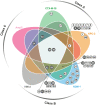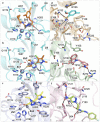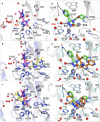Virtual screening identifies broad-spectrum β-lactamase inhibitors with activity on clinically relevant serine- and metallo-carbapenemases
- PMID: 32728062
- PMCID: PMC7391774
- DOI: 10.1038/s41598-020-69431-y
Virtual screening identifies broad-spectrum β-lactamase inhibitors with activity on clinically relevant serine- and metallo-carbapenemases
Abstract
Bacteria are known to evade β-lactam antibiotic action by producing β-lactamases (BLs), including carbapenemases, which are able to hydrolyze nearly all available β-lactams. The production of BLs represents one of the best known and most targeted mechanisms of resistance in bacteria. We have performed the parallel screening of commercially available compounds against a panel of clinically relevant BLs: class A CTX-M-15 and KPC-2, subclass B1 NDM-1 and VIM-2 MBLs, and the class C P. aeruginosa AmpC. The results show that all BLs prefer scaffolds having electron pair donors: KPC-2 is preferentially inhibited by sulfonamide and tetrazole-based derivatives, NDM-1 by compounds bearing a thiol, a thiosemicarbazide or thiosemicarbazone moiety, while VIM-2 by triazole-containing molecules. Few broad-spectrum BLs inhibitors were identified; among these, compound 40 potentiates imipenem activity against an NDM-1-producing E. coli clinical strain. The binary complexes of the two most promising compounds binding NDM-1 and VIM-2 were obtained at high resolution, providing strong insights to improve molecular docking simulations, especially regarding the interaction of MBLs with inhibitors.
Conflict of interest statement
The authors declare no competing interests.
Figures




Similar articles
-
4-Alkyl-1,2,4-triazole-3-thione analogues as metallo-β-lactamase inhibitors.Bioorg Chem. 2021 Aug;113:105024. doi: 10.1016/j.bioorg.2021.105024. Epub 2021 May 26. Bioorg Chem. 2021. PMID: 34116340
-
Sulfamoyl Heteroarylcarboxylic Acids as Promising Metallo-β-Lactamase Inhibitors for Controlling Bacterial Carbapenem Resistance.mBio. 2020 Mar 17;11(2):e03144-19. doi: 10.1128/mBio.03144-19. mBio. 2020. PMID: 32184250 Free PMC article.
-
Broad-Spectrum Inhibitors against Class A, B, and C Type β-Lactamases to Block the Hydrolysis against Antibiotics: Kinetics and Structural Characterization.Microbiol Spectr. 2022 Oct 26;10(5):e0045022. doi: 10.1128/spectrum.00450-22. Epub 2022 Sep 7. Microbiol Spectr. 2022. PMID: 36069578 Free PMC article.
-
Ten Years with New Delhi Metallo-β-lactamase-1 (NDM-1): From Structural Insights to Inhibitor Design.ACS Infect Dis. 2019 Jan 11;5(1):9-34. doi: 10.1021/acsinfecdis.8b00247. Epub 2018 Nov 28. ACS Infect Dis. 2019. PMID: 30421910 Review.
-
New Carbapenemase Inhibitors: Clearing the Way for the β-Lactams.Int J Mol Sci. 2020 Dec 6;21(23):9308. doi: 10.3390/ijms21239308. Int J Mol Sci. 2020. PMID: 33291334 Free PMC article. Review.
Cited by
-
Docking and Molecular Dynamic of Microalgae Compounds as Potential Inhibitors of Beta-Lactamase.Int J Mol Sci. 2022 Jan 31;23(3):1630. doi: 10.3390/ijms23031630. Int J Mol Sci. 2022. PMID: 35163569 Free PMC article.
-
β-Lactam potentiators to re-sensitize resistant pathogens: Discovery, development, clinical use and the way forward.Front Microbiol. 2023 Mar 10;13:1092556. doi: 10.3389/fmicb.2022.1092556. eCollection 2022. Front Microbiol. 2023. PMID: 36970185 Free PMC article. Review.
-
Drug Discovery in the Field of β-Lactams: An Academic Perspective.Antibiotics (Basel). 2024 Jan 8;13(1):59. doi: 10.3390/antibiotics13010059. Antibiotics (Basel). 2024. PMID: 38247618 Free PMC article. Review.
-
Computational Modeling and Design of New Inhibitors of Carbapenemases: A Discussion from the EPIC Alliance Network.Int J Mol Sci. 2022 Aug 28;23(17):9746. doi: 10.3390/ijms23179746. Int J Mol Sci. 2022. PMID: 36077146 Free PMC article.
-
Strategies to Name Metallo-β-Lactamases and Number Their Amino Acid Residues.Antibiotics (Basel). 2023 Dec 16;12(12):1746. doi: 10.3390/antibiotics12121746. Antibiotics (Basel). 2023. PMID: 38136780 Free PMC article. Review.
References
-
- Watkins RR, Bonomo RA. β-Lactam Antibiotics. In: Cohen J, Powderly WG, Opa SM, editors. Infectious Diseases. Amsterdam: Elsevier; 2016. pp. 1203–1216.
-
- WHO . Antimicrobial Resistance. Global Report on Surveillance. Geneva: World Health Organization; 2014.
-
- Bush K. Carbapenemases: partners in crime. J. Glob. Antimicrob. Resist. 2013;1:7–16. - PubMed
-
- Farina D, et al. The inhibition of extended spectrum beta-lactamases: hits and leads. Curr. Med. Chem. 2014;21:1405–1434. - PubMed
Publication types
MeSH terms
Substances
LinkOut - more resources
Full Text Sources
Other Literature Sources
Miscellaneous

